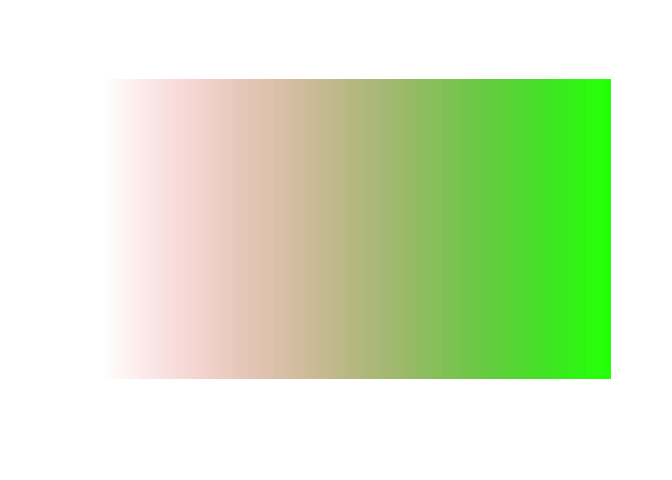Assigns Colours to Values.
colourvalues

What does it do?
It maps viridis colours (by default) to values, and quickly!
Note It does not perform a 1-to-1 mapping of a palette to values. It interpolates the colours from a given palette.
Why did you build it?
I’m aware there are other methods for mapping colours to values. And which do it quick too. But I can never remember them, and I find the interfaces a bit cumbersome. For example, scales::col_numeric(palette = viridisLite::viridis(5), domain = range(1:5))(1:5).
I wanted one function which will work on one argument.
colour_values(1:5)
# [1] "#440154FF" "#3B528BFF" "#21908CFF" "#5DC963FF" "#FDE725FF"
colour_values(letters[1:5])
# [1] "#440154FF" "#3B528BFF" "#21908CFF" "#5DC963FF" "#FDE725FF"
I also want it available at the src (C/C++) level for linking to other packages.
Why do you spell colour with a ‘u’?
Because it’s correct, and R tells us to
For consistency, aim to use British (rather than American) spelling
But don’t worry, color_values(1:5) works as well
How do I install it?
From CRAN
install.packages("colourvalues")
Or install the development version from GitHub with:
# install.packages("devtools")
devtools::install_github("SymbolixAU/colourvalues")
How can I make use of it in my package?
Rcpp
All functions are written in Rcpp. I have exposed some of them in header files so you can “link to” them in your package.
For example, the LinkingTo section in DESCRIPTION will look something like
LinkingTo:
Rcpp,
colourvalues
And in a c++ source file so you can #include the API header
#include "colourvalues/api.hpp"
// [[Rcpp::depends(colourvalues)]]
And call
// return hex colours
colourvalues::api::colour_values_hex()
// return RGP matrix
colourvalues::api::colour_values_rgb()
R
If you’re not using Rcpp, just Import this package like you would any other.
Do you have any examples?
Of course!
256 numbers mapped to a colour
bar_plot <- function(df) {
barplot( height = df[["a"]], col = df[["col"]], border = NA, space = 0, yaxt = 'n')
}
df <- data.frame(a = 10, x = 1:256)
df$col <- colour_values(df$x, palette = "viridis")
bar_plot( df )

5000 numbers on a non-linear scale
df <- data.frame(a = 10, x = c((1:5000)**3))
df$col <- colour_values(df$x, palette = "viridis")
bar_plot( df )

1000 random numbers
df <- data.frame(a = 10, x = rnorm(n = 1000))
df$col <- colour_values(df$x, palette = "inferno")
bar_plot( df )

Eurgh!
df <- df[with(df, order(x)), ]
bar_plot( df )

That’s better!
Are there only viridis palettes?
No, you can chose one from
colour_palettes()
# [1] "viridis" "cividis" "magma" "inferno"
# [5] "plasma" "ylorrd" "ylorbr" "ylgnbu"
# [9] "ylgn" "reds" "rdpu" "purples"
# [13] "purd" "pubugn" "pubu" "orrd"
# [17] "oranges" "greys" "greens" "gnbu"
# [21] "bupu" "bugn" "blues" "spectral"
# [25] "rdylgn" "rdylbu" "rdgy" "rdbu"
# [29] "puor" "prgn" "piyg" "brbg"
# [33] "terrain" "topo" "heat" "cm"
# [37] "rainbow" "terrain_hcl" "heat_hcl" "sequential_hcl"
# [41] "rainbow_hcl" "diverge_hcl" "diverge_hsv" "ygobb"
# [45] "matlab_like2" "matlab_like" "magenta2green" "cyan2yellow"
# [49] "blue2yellow" "green2red" "blue2green" "blue2red"
And you can use show_colours() to view them all. Here’s what some of them look like
show_colours( colours = colour_palettes(c("viridis", "colorspace")))

Do I have to use the in-built palettes?
No, you can use your own specified as a matrix of red, green and blue columns in the range [0,255]
n <- 100
m <- grDevices::colorRamp(c("red", "green"))( (1:n)/n )
df <- data.frame(a = 10, x = 1:n)
df$col <- colour_values(df$x, palette = m)
bar_plot( df )

Do you support ‘alpha’ values
Yep. Either supply a single alpha value for all the colours
## single alpha value for all colours
df <- data.frame(a = 10, x = 1:255)
df$col <- colour_values(df$x, alpha = 50)
bar_plot( df )

Or use a vector of values the same length as x
df <- data.frame(a = 10, x = 1:300, y = rep(c(1:50, 50:1), 3) )
df$col <- colour_values(df$x, alpha = df$y)
bar_plot( df )

Or include the alpha value as a 4th column in the palette matrix
n <- 100
m <- grDevices::colorRamp(c("red", "green"))( (1:n)/n )
## alpha values
m <- cbind(m, seq(0, 255, length.out = 100))
df <- data.frame(a = 10, x = 1:n)
df$col <- colour_values(df$x, palette = m)
bar_plot( df )

Some of my plotting functions don’t support alpha, can I exclude it?
Yep. Set include_alpha = FALSE
colour_values(1:5, include_alpha = F)
# [1] "#440154" "#3B528B" "#21908C" "#5DC963" "#FDE725"
colour_values_rgb(1:5, include_alpha = F)
# [,1] [,2] [,3]
# [1,] 68 1 84
# [2,] 59 82 139
# [3,] 33 144 140
# [4,] 93 201 99
# [5,] 253 231 37
Can I get a summary of colours to use in a legend?
Yes, for numeric values use the n_summaries argument to specify the number of summary values you’d like
colour_values(1:10, n_summaries = 3)
# $colours
# [1] "#440154FF" "#482878FF" "#3E4A89FF" "#31688EFF" "#26838EFF" "#1F9D89FF"
# [7] "#35B779FF" "#6CCE59FF" "#B4DD2CFF" "#FDE725FF"
#
# $summary_values
# [1] "1.00" "5.50" "10.00"
#
# $summary_colours
# [1] "#440154FF" "#21908CFF" "#FDE725FF"
You can also specify the number of digits you’d like returned in the summary
colour_values(rnorm(n = 10), n_summaries = 3, digits = 2)
# $colours
# [1] "#FDE725FF" "#440154FF" "#5CC863FF" "#3F4889FF" "#443A83FF" "#1E9D89FF"
# [7] "#1E9C89FF" "#77D153FF" "#4EC36BFF" "#2D718EFF"
#
# $summary_values
# [1] "-1.27" "0.36" "1.99"
#
# $summary_colours
# [1] "#440154FF" "#21908CFF" "#FDE725FF"
You can also use format = FALSE if you don’t want the summary values formatted.
dte <- seq(as.Date("2018-01-01"), as.Date("2018-02-01"), by = 1)
colour_values(dte, n_summaries = 3)
# $colours
# [1] "#440154FF" "#470D60FF" "#48196BFF" "#482474FF" "#472E7CFF" "#453882FF"
# [7] "#414286FF" "#3E4B8AFF" "#3A548CFF" "#365D8DFF" "#32658EFF" "#2E6D8EFF"
# [13] "#2B758EFF" "#287D8EFF" "#25858EFF" "#228C8DFF" "#20948CFF" "#1E9C89FF"
# [19] "#20A386FF" "#25AB82FF" "#2DB27DFF" "#39BA76FF" "#48C16EFF" "#58C765FF"
# [25] "#6ACD5BFF" "#7ED34FFF" "#92D742FF" "#A8DB34FF" "#BEDF26FF" "#D4E21BFF"
# [31] "#E9E41AFF" "#FDE725FF"
#
# $summary_values
# [1] "2018-01-01" "2018-01-16" "2018-02-01"
#
# $summary_colours
# [1] "#440154FF" "#21908CFF" "#FDE725FF"
colour_values(dte, n_summaries = 3, format = F)
# $colours
# [1] "#440154FF" "#470D60FF" "#48196BFF" "#482474FF" "#472E7CFF" "#453882FF"
# [7] "#414286FF" "#3E4B8AFF" "#3A548CFF" "#365D8DFF" "#32658EFF" "#2E6D8EFF"
# [13] "#2B758EFF" "#287D8EFF" "#25858EFF" "#228C8DFF" "#20948CFF" "#1E9C89FF"
# [19] "#20A386FF" "#25AB82FF" "#2DB27DFF" "#39BA76FF" "#48C16EFF" "#58C765FF"
# [25] "#6ACD5BFF" "#7ED34FFF" "#92D742FF" "#A8DB34FF" "#BEDF26FF" "#D4E21BFF"
# [31] "#E9E41AFF" "#FDE725FF"
#
# $summary_values
# [1] 17532.0 17547.5 17563.0
#
# $summary_colours
# [1] "#440154FF" "#21908CFF" "#FDE725FF"
For categorical values use summary = TRUE to return a uniqe set of the values, and their associated colours
colour_values(sample(letters, size = 50, replace = T), summary = T)
# $colours
# [1] "#277F8EFF" "#63CB5FFF" "#63CB5FFF" "#1FA187FF" "#3C4F8AFF" "#365C8DFF"
# [7] "#FDE725FF" "#365C8DFF" "#1FA187FF" "#471365FF" "#365C8DFF" "#DFE318FF"
# [13] "#238A8DFF" "#3C4F8AFF" "#80D34DFF" "#46327FFF" "#35B779FF" "#471365FF"
# [19] "#440154FF" "#26AC81FF" "#1FA187FF" "#2C748EFF" "#63CB5FFF" "#FDE725FF"
# [25] "#80D34DFF" "#46327FFF" "#1F968BFF" "#BFDF25FF" "#3C4F8AFF" "#2C748EFF"
# [31] "#9FDA3AFF" "#31688EFF" "#4AC26DFF" "#4AC26DFF" "#3C4F8AFF" "#4AC26DFF"
# [37] "#35B779FF" "#9FDA3AFF" "#1FA187FF" "#26AC81FF" "#482374FF" "#1F968BFF"
# [43] "#26AC81FF" "#FDE725FF" "#4AC26DFF" "#3C4F8AFF" "#277F8EFF" "#35B779FF"
# [49] "#80D34DFF" "#424186FF"
#
# $summary_values
# [1] "b" "c" "d" "e" "f" "g" "h" "i" "j" "k" "m" "n" "o" "p" "q" "r" "s" "u" "v"
# [20] "w" "x" "y"
#
# $summary_colours
# [1] "#440154FF" "#471365FF" "#482374FF" "#46327FFF" "#424186FF" "#3C4F8AFF"
# [7] "#365C8DFF" "#31688EFF" "#2C748EFF" "#277F8EFF" "#238A8DFF" "#1F968BFF"
# [13] "#1FA187FF" "#26AC81FF" "#35B779FF" "#4AC26DFF" "#63CB5FFF" "#80D34DFF"
# [19] "#9FDA3AFF" "#BFDF25FF" "#DFE318FF" "#FDE725FF"
I see you support lists, but how does it work?
Basically, it’s the same as un-listing the list to create a vector of all the values, then colouring them.
So if your list contains different types, it will coerce all values to the same type and colour them.
But it returns a list of the same structure.
For example,
l <- list( x = 1:5, y = list(z = letters[1:5] ) )
colour_values( l )
# [[1]]
# [1] "#440154FF" "#482878FF" "#3E4A89FF" "#31688EFF" "#26838EFF"
#
# [[2]]
# [[2]][[1]]
# [1] "#1F9D89FF" "#35B779FF" "#6CCE59FF" "#B4DD2CFF" "#FDE725FF"
x <- c( 1:5, letters[1:5] )
colour_values( x )
# [1] "#440154FF" "#482878FF" "#3E4A89FF" "#31688EFF" "#26838EFF" "#1F9D89FF"
# [7] "#35B779FF" "#6CCE59FF" "#B4DD2CFF" "#FDE725FF"
What it doesn’t do is treat each list element independently. For this you would use
lapply( l, colour_values )
# $x
# [1] "#440154FF" "#3B528BFF" "#21908CFF" "#5DC963FF" "#FDE725FF"
#
# $y
# $y[[1]]
# [1] "#440154FF" "#3B528BFF" "#21908CFF" "#5DC963FF" "#FDE725FF"
What’s the performance like?
10 million numeric values
library(microbenchmark)
library(scales)
library(viridisLite)
n <- 1e7
df <- data.frame(x = rnorm(n = n))
m <- microbenchmark(
colourvalues = { colourvalues::colour_values(x = df$x) },
scales = { col_numeric(palette = rgb(subset(viridis.map, opt=="D")[, 1:3]), domain = range(df$x))(df$x) },
times = 25
)
# Warning in microbenchmark(colourvalues = {: less accurate nanosecond times to
# avoid potential integer overflows
m
# Unit: milliseconds
# expr min lq mean median uq max neval
# colourvalues 789.3592 797.2215 808.1314 805.4144 810.2691 866.7162 25
# scales 1696.3621 1761.6745 1820.4097 1793.3245 1865.7442 2118.4543 25
1 million characters (26 unique values)
library(microbenchmark)
library(scales)
library(viridisLite)
n <- 1e6
x <- sample(x = letters, size = n, replace = TRUE)
df <- data.frame(x = x)
m <- microbenchmark(
colourvalues = { x <- colourvalues::colour_values(x = df$x) },
scales = { y <- col_factor(palette = rgb(subset(viridis.map, opt=="D")[, 1:3]), domain = unique(df$x))(df$x) },
times = 25
)
m
# Unit: milliseconds
# expr min lq mean median uq max neval
# colourvalues 90.27962 90.81623 91.88558 90.93574 91.61257 104.2933 25
# scales 195.65930 198.46062 203.90773 200.45052 204.15282 228.5454 25
